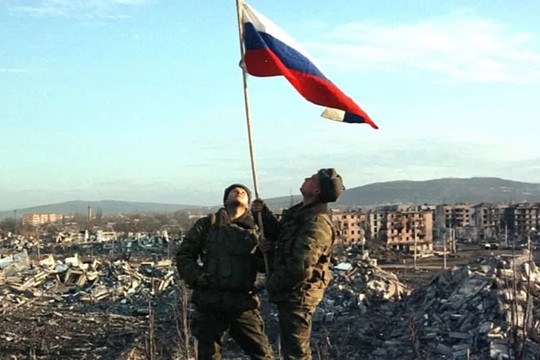The Russian flag over Artyomovsk (known in Ukraine as Bakhmut)
- The head of Russian private military company (PMC) Wagner, Evgeny Prigozhin, has announced a milestone achievement in the battle for the city of Artyomovsk (known in Ukraine as Bakhmut), publishing a video taken in front of the town’s administrative building on April 2 evening where the Russian flag was hoisted. The enemy is concentrated in the western districts of the city, he said.
There is no planned withdrawal of the Ukrainian army from Artyomovsk (Ukrainian name Bakhmut) in sight, the acting head of the DPR Denis Pushilin said on April 3.
Artyomovsk, located in the Kiev-controlled part of the DPR, is an important transport hub, crucial to delivering supplies to the Ukrainian group of troops in Donbass. Fierce battles are going on for the city. As the adviser to the acting head of the DPR, Yan Gagin, said earlier, Russian forces control up to 70% of the city's territory. Also, all paved roads leading there have already been cut or are under the fire control of the Russian forces, which greatly complicates the delivery of supplies to the Ukrainian group.
- Russian airborne troops for the first time in history received the TOS-1A "Solntsepyok" heavy "flamethrower" systems, and they will be used in the special operation zone in Ukraine, the Defense Ministry revealed. Colonel Alexei Goncharov, who heads the Airborne NBC Protection Troops, noted that these systems "have no equal in the collective West's arsenals," so they "induce panic among our enemies."
The heavy "flamethrower" system TOS-1A "Solntsepyok" (or in English “Scorching Sun”) is designed to incapacitate an enemy's lightly armored vehicles, cars, buildings, fortifications and manpower at a distance of up to six kilometers. It can create maximum temperature near the target around 3,000 degrees Celcius.
- Kiev has completed the recruitment of its so-called “Attack Guard,” which has been assembled with the aim of retaking territories lost to Russia during the ongoing conflict, Ukrainian Interior Minister Igor Klimenko has said, claiming that by beginning of April eight new brigades have been set up. He didn’t reveal the exact number of personnel in the new force, but a Ukrainian brigade usually consists of between 3,000 to 5,000 servicemen. It is 24,000 (min) or 40,000 (max).
That is not enough to conduct any offensive or counter-offensive.
- The United States need to be pushing for peace in Ukraine, not funding a proxy war with Russia, Congresswoman Marjorie Taylor Greene said during an interview. "We can't afford another foreign war," she said, pointing out that Ukraine was not a NATO member nation nor the 51st state of the US.
Last April, Russia sent a note of protest to NATO on account of its weapons deliveries to Ukraine. Russian Minister of Foreign Affairs Sergey Lavrov said that any such deliveries would be a legitimate aim of the Russian military and that the NATO are "playing with fire."
- The Istanbul Grain Deal was arranged by the UN and Turkiye between Russia and Ukraine in July 2022 to ease exports of grain and fertilizer from Black Sea ports amid the ongoing hostilities. It has since been extended twice, with Moscow warning that most vessels do not reach the world's poorest countries and end up in Europe.
Eastern member-states of the European Union are beginning to question continued support for Ukraine as they cope with a glut of grain that has been triggering anger among their communities, according to US media reports.
Europe was supposed to be a transit territory for Ukraine’s cheap and sometimes low quality grain, originally meant for poor countries in Africa, but the huge influx of duty-free imports is staying on the continent and, hitting local farmers in Poland, Romania, Slovakia, Hungary and Bulgaria.
read more in our Telegram-channel https://t.me/The_International_Affairs

 10:02 07.04.2023 •
10:02 07.04.2023 •























